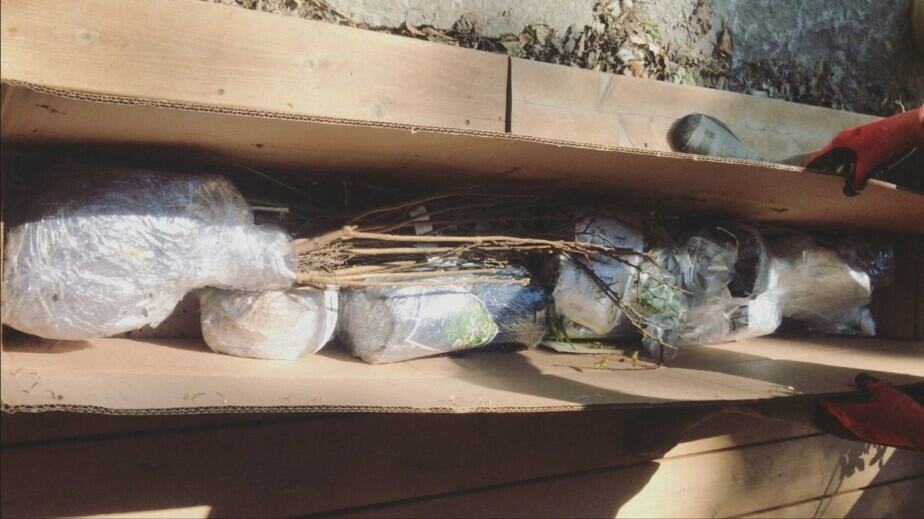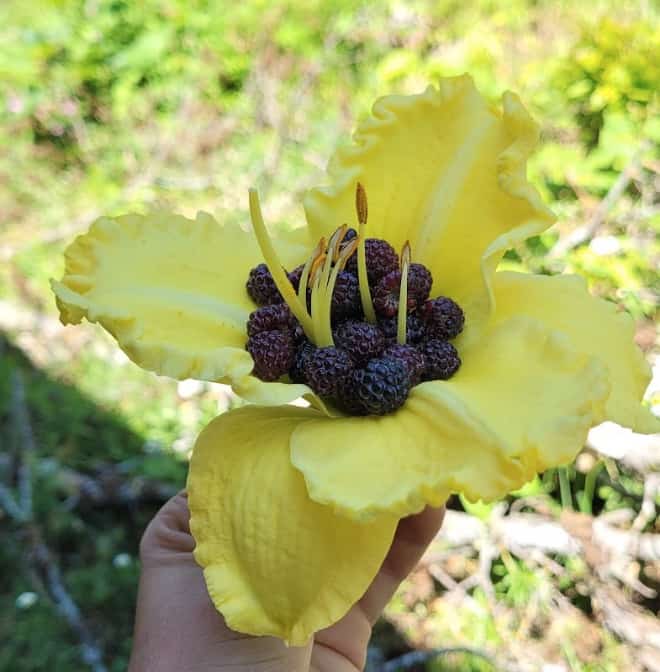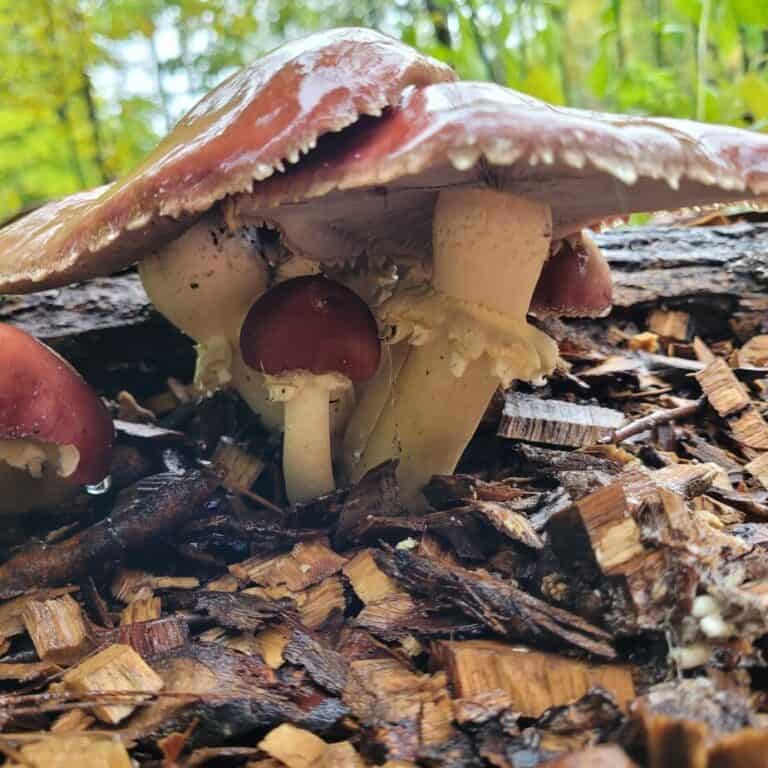This post may contain affiliate links. If you use these links to buy something we may earn a commission. Thanks.
With the inevitable need for change, we all want a producing forest garden yesterday. It’s true, a forest garden will take longer than a vegetable garden to produce rewarding harvests. All we can do now is get started as soon as we can.
The time it takes to grow a food forest is determined by how long it takes you to prepare and plant it and how long the plants take to grow until productivity. The upper layers can take a decade while the lower layers can take as little as months to produce food.
For any sized food forest; you will need to spend time researching suitable plants, preparing for planting, sourcing protective materials, and sourcing the plants before you actually spend the time getting them planted.
The length of time until maturity happens at different intervals. It depends on the layer and plant type.
The rest of this article entails the expected timelines in detail:
- First how long it might take to do things, and
- second how long the plants take to mature (layer by layer!)
How much time will it take to plant a small food forest?
To put this in perspective; you might spend a little more time preparing and planning for a permanent food forest than you would for an annual vegetable garden that can change every year. Regardless of the size!
In our experience, it takes a certain average amount of time to get each step done.
For a single guild, a small food forest, it takes 6 hours on average from prep to planted. It takes about one hour to prepare a 16-square-foot space. One hour to decide, research, and situate the desired plants. Three hours to obtain the plants and an hour to plant them all at once.
Skip to: How long does a food forest take to mature
I’ll explain the average timeline:
To prepare your first (perhaps only) guild, you’ll use a spade to dig out and flip grasses or weeds. Flipping them over so there is soil on top. Rake this smooth and lay sheet mulch. In well-drained soils, dig a moat around the expected mature drip line of the tree. The guild will collect and absorb more water. Fill this moat with organic matter such as sticks, leaves, and woodchips. Collecting the material and doing the work takes about an hour for a 16-square-foot space.
While your bed rests in the dark, research which plants thrive best around your choice of tree. Your tree will also appreciate you finding plants that help it thrive too. You’ll want a mix of plants that provide different roles.
For example, a fruit tree guild benefits from planting daffodils around its base. Daffodils deter deer or other critters from grazing the tree trunk. Other plant choices have their unique essential functions too!
I encourage you to take at least an hour to do some research on suitable plant choices! A good assortment relies on eaches purpose.
Related post: How To Find and Pick the Best Plants for Any Forest Garden
To get your plants, we say it takes three hours. You can either shop online, shop at a nursery, or bargain with the neighbors. Each choice comes with time-consuming qualities. Shopping online means you need to read a lot. Shopping in person means you need to get there, look around, find things, and drive home. Bargaining with the neighbors is quick but also delayed. You might not find everything you need from a single neighbor.
Finally, planting everything all at once takes on average about an hour. A bare-root fruit tree will take about 10 minutes to gently unwrap, and soak in a bucket while removing the sheet mulch. Digging the hole and separating topsoil from the undersoil takes about 5-10 minutes. To carefully plant the tree at an appropriate height will take another 10 minutes. Replacing the soil in the way it came out will take 2 minutes. Use the rest of the time to replace the sheet mulch, make holes to plant your smaller items around the tree, and water it well.
To help give you a realistic idea of how much time it takes to start a small food forest, we’ve based these numbers on our ongoing experience.
How much time will it take to plant a big food forest?
Unless you are going to start a community forest garden, most big food forests are done in gradual stages. By talking to several forest gardeners, I found an average time we all take to plant our ever-expanding food forests.
On average, it takes six hours of time each week to gradually fill a large forest garden over many ongoing years. Planting includes research here and there, sourcing plants, preparing soil, and getting plants tucked in!
Some parts of the season may take double the time while other parts of the season may take none of the time.
My best advice for “de-clumping” your time expenditure is to ensure you are prepared! When we first started, the two of us had a couple of dozen trees and shrubs to plant. It was a decent-sized order that took us a WEEK to get everything in! Had we been prepared properly . . . it could have taken a day or two.

Sure, we picked out a spot to put every tree before they arrived. But did we prepare the soil for planting? No! Half the trees we planted were in shallow, rocky, steep-sloped established grass. Yes, we disturbed the grass. Yes, we mulched the new trees… But did those trees survive? Nearly two, but only one. The biggest mistakes were leaving the rough terrain intact—a big demotivator for hand-watering young trees—and proper tree protection not purchased or installed!
The other half had reasonably walkable sites, and they are all alive today. Only struggling now after regular deer grazing.
Update: only 3 trees of that order are confirmed dead! That is the benefit of ordering healthy trees is that they can endure a lot before giving up . . . Even the one that had a 30-inch oak fall on it during a storm had survived!
Before ordering even healthy trees, take the time to prepare your soil, forge accessible pathways, and purchase critter protection equipment. Even if that looks like sheet mulching a new area an entire season in advance! You’ll save yourself a lot of stress, hard work, and burnout because rushing will only set you back to zero.
How long does a food forest take to mature?
The maturity time of a food forest isn’t black and white. But there is an average timeline you can expect food to become increasingly abundant.
In general, it takes 7 years to establish a mature food forest. By this time the majority of plants will be producing food (assuming the slowest plants were planted first). Each layer of a food forest has a different broad range of time to maturity.
To understand this better, we can ask:
What can you grow in a food forest?
You can grow a mix of perennials, annuals, and biennials in a forest garden. Certain layers are always perennial, the rest can be a mix. Each layer takes a different amount of time to grow and depends on the plant at hand.
Annuals provide harvest within a single season.
Biennials are hardy to your zone, but complete their lifespan within 2 seasons. They can provide a harvest within the first season and/or the next, depending on what you want to harvest from it.
Perennials are hardy to your climate and have a life cycle of at least 3 years or more. The more perennial plants, the longer a forest garden will be before change or cause the need for maintenance.
How long does it take to grow a canopy layer?
In general, long-standing perennials are in the canopy, sub-canopy, and shrub layers.
Canopy plants often live for at least a decade and up to centuries. The oldest 5000-year-old tree known is a great Basin Bristlecone Pine! Pines are a canopy layer tree. So yes, they can live very long and produce food for the longest time. What might that mean? They also take longer to mature.
In general, it takes between 6-20 years for canopy trees to reach productive maturity.
Forest garden canopy trees include large fruit and nut trees, and other natives. They can be grown for medicine, sap, windbreak, or wood.
One of my must-have canopy nut trees is the Korean pine. Pinecones won’t form to produce pine nuts until they surpass the vegetative state of growth. They take about 10 years to produce nuts.

Maple trees need a circumference of at least 10 inches for tolerable sap harvest. The time it takes to reach this level of maturity depends on the conditions provided.
For faster maturity; provide fertile soil, mulch well, give space, and choose trees that are comfortable in your zone.
How long does it take to grow a fruiting understory layer?
The understory layer has smaller dwarfed fruit trees. These trees are more manageable in size and don’t grow monstrously. So it makes sense that dwarfed trees take less time to mature.
It takes between 2-7 years for understory trees to bear fruit. The type of tree, how old the trees are when received, and the conditions provided for the tree will impact time.
| Tree Type | Time until productive |
| Apple & apricot trees | 2-5 years |
| Nectarine & peach trees | 2-4 years |
| Persimmon trees | 3-4 years |
| Plum trees | 3-6 years |
| Pear trees | 4-6 years |
| Cherry trees | 3-7 years |
| Pawpaw trees | 5-7 years |
How long does it take to grow a fruiting shrub layer?
The shrub layer has a wide range of growth rates.
It takes between 2 and 5 years for shrubs to produce fruit. Quick-growing shrubs like raspberries, blackberries, and thimbleberries produce fruit in their second year. Slow-growing shrubs like blueberries, cranberries, and elderberries produce in three to five years.
How long does it take to grow a mature herbaceous layer?
Herbaceous perennials are lower-growing plants that live beyond two years. Like fruit trees and shrubs, their foliage dies back but their roots stay alive. Unlike fruit trees and shrubs, they don’t get woody. Examples are grasses, flowers, fragrant herbs, and leafy greens.
It takes between 1-3 years to grow herbaceous perennials for sustainable harvesting. From seed, most perennial herbs establish their roots in year one, grow vegetation in year two, and reproduce by year three. Faster-growing perennials can get the job done over a whole year.
We sowed bergamot bee balm in late winter and planted it out in spring. One spring later we harvested plenty of flowers for tea! This is an example of a fast-growing herb that matured over a year.
Daylilies are an example of a 3-year herb. We save seeds from daylilies and sow them crowded in a pot in early fall so they stratify over winter. In late winter we bring them indoors for a headstart until it is warm enough outside to grow. By autumn of the same year, we transplant them into their permanent place. In the second year, they may bloom but they are more focused on vegetative growth. In the third spring, they are ready for harvesting young shoots and delicious flowers.

How long does it take to grow a mature ground cover layer?
The ground cover layer is like the herbaceous layer. The contrast is they tend to stay low and spread out rather than growing upward.
It takes 0-3 years for a mature ground cover layer in a food forest. In a short time, ground cover plants may be edible, but not necessarily matured into their desired purpose. It’s not only about when it’s sustainably edible but also about soil coverage where we want it.
If you chose slow-growing versus fast-growing or seeded covers, they take more or less time to fill in.
For a fast mature ground cover layer, you’ll want to opt for sowing seeds. Planting a single ground cover plant and waiting for it to establish and spread takes far longer.
Clover is a seeded ground cover that can provide edible greens and flowers within a season.
Transplanted strawberries can produce fruit in a matter of weeks. But if you want soil coverage, and establishment you’ll need to wait longer for them to spread out.
How long does it take to grow a climbing vine layer?
The vine layer has plants that like to climb! Hardy kiwi and grapes make good examples.
It can take between 3-9 years for vines to produce fruit. However, you can eat foliage from the vine layer in the first year and onward.
Grapes are vigorous-growing vines that have edible leaves! To get faster fruit, you’ll need to prune extra shoots away starting in the first year. You can propagate, drop on the ground, or eat the leaves of cuttings.
Hardy kiwi vines can take 5-9 years to produce fruit and they too have edible leaves!
How long does it take to grow a root layer?
The root layer has plants that are grown specifically for edible roots. Many plants from other layers also have edible roots but are usually consumed in other ways.
It takes 2 years before you can harvest perennial tubers from the root layer. In their first year, they focus on vegetative growth, and in the second year they can size up their tubers.

Valerian, scorzonera, sunchokes, and arrowheads are examples of perennial root-layer crops.
How long does it take to grow a mushroom layer?
The mushroom layer can grow from the ground, dead wood, and live wood! The length of time it takes to grow your desired mushrooms vary depending on the type of mushroom. What is the range of time it takes to grow any mushroom?
It takes 2 months to 7 years to produce the desired mushroom layer. Wine cap mushrooms can fruit in as little as 2 months. Truffle mushrooms can take up to 7 years to finally fruit!
We inoculated our plum tree beds with wine caps in the spring of 2019. That same year, we had huge hauls of wine caps in autumn of the same year. It was a 4-month wait for the right conditions.

The time mushrooms take to fruit depends on the conditions and quantity of food provided.
Related posts:
Truffles have very picky prerequisites! These guys are the 7 year-long mushroom that makes the timeline range so high.
If you don’t plan to grow this rare variety of fungi, you can expect 2 months to 2 years for everything else.
This article was originally published on foodforestliving.com. If it is now published on any other site, it was done without permission from the copyright owner.
Recent Posts
There’s no shortage of full-sun ground covers for zone 4 climates! Each plant in this list can withstand the frigid temperatures and also enjoy the hot sun in summer. Full sun means that a plant...
There's no shortage of full sun ground covers, not even in zone 3! Zone 3 climates offer hot but short-lived summers and very cold winters. So each plant in this list can withstand the frigid...
